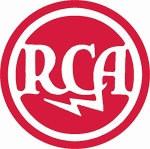The RCA Studio Cameras…In the Beginning
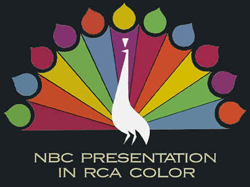 The Radio Corporation of America was formed in 1919 as a publicly held company owned by General Electric. There were many glory years and many, many innovations in RCA’s history, but it all came to an end in 1986 when the company that had formed RCA, GE, bought them and took it all apart. Although gone, RCA is not forgotten.
The Radio Corporation of America was formed in 1919 as a publicly held company owned by General Electric. There were many glory years and many, many innovations in RCA’s history, but it all came to an end in 1986 when the company that had formed RCA, GE, bought them and took it all apart. Although gone, RCA is not forgotten.
I have written a much fuller history on RCA and you can read it in Volume 1 of “The History Of NBC’s New York Studios” in the Studios section. Here though, I want to introduce you to the early cameras from RCA: the Iconoscopes and Orthicon cameras that came before the great line of TK Image Orthicon line debuted in June of 1946.
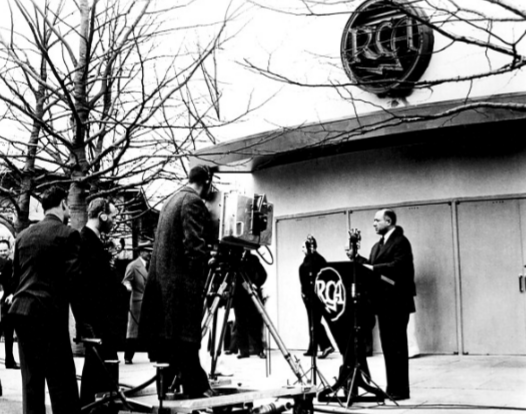
Let’s start with a surprising dash of sophistication. Above (1939) and below (1938) are images of RCA’s first remote use Iconoscope cameras. Notice on the right side, there is a geared wheel on the camera body. I think you will be surprised to find out what this is, but I’ll give you a minute to guess. For its day, it was quite sophisticated.
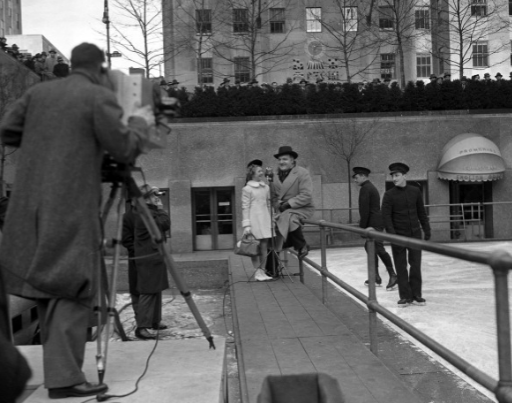
Believe it or not, that apparatus is a remotely controlled focus demand. It is not operated by the cameraman. It is controlled from inside the new NBC Telemobile Unit. That was the only place the video output could be seen in the camera chain, as all the camera operator had to line up the shot was a small peephole…a hollow pipe through the camera body, and later, a wire “gunsight” on the left side.
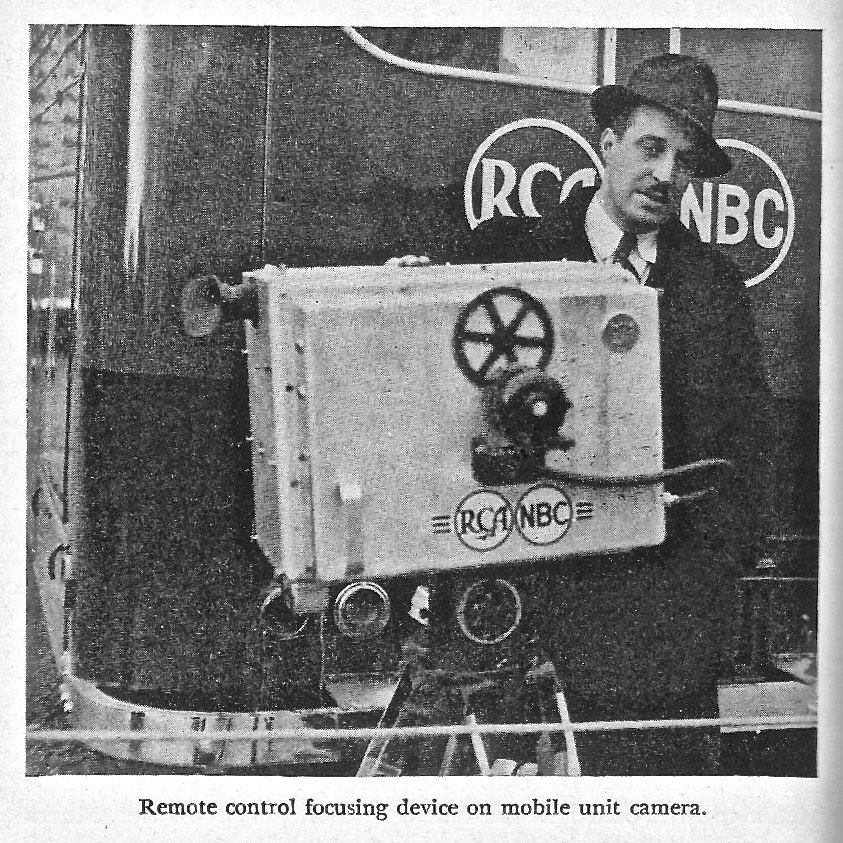
On December 12, 1937, an RCA mobile system, consisting of two 26 foot buses, was delivered to NBC in New York City. One motor van provided two portable single-lens Iconoscope cameras and their support equipment. The second van contained the 177 MHz transmitter with antenna, which could relay a remote pickup to the Empire State Building from as far away as 25 miles.
The units were tested for about six months before being returned to RCA’s Camden plant for modifications in the synchronizing equipment. Another modification was the installation of a coaxial feed out the transmitter truck, which allowed the unit to operate and make pictures around 30 Rockefeller Plaza without transmitting the image.
The trucks came back around August, and on September 15, 1938, NBC conducted the first sidewalk interview with passers-by in Rockefeller Plaza (via the new coax). By the time the 1939 World’s Fair came to town, NBC had a lot of experience with the units and used them heavily at the Fair.
By the way, if you thought parabolic dish microphones were an invention of the ’60s and developed for football sidelines audio, think again. There was one on this mobile unit.
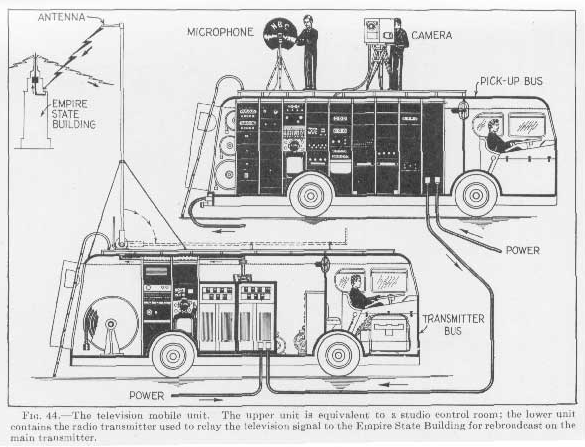
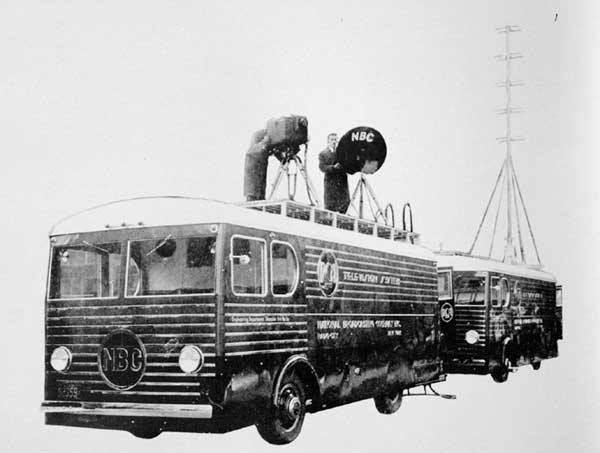
At this link you can see these units in action, as well as some great studio footage from NBC Studio 3H with the big, silver A500 model Iconoscope cameras. It is with this, that I will segue to the early studio cameras section.
Below is NBC’s first studio cameraman, Albert Protzman, with the early version of the RCA studio Iconoscope camera. Notice that the although the camera body will change colors from umber gray to silver, and will undergo upgrades in resolution from 180 lines all the way to 525 lines, the camera housing will stay the same…literally. All the modifications were done inside the housing, so the three camera bodies that started in 3H in 1935 are the same camera bodies that were retired in the spring of 1946.
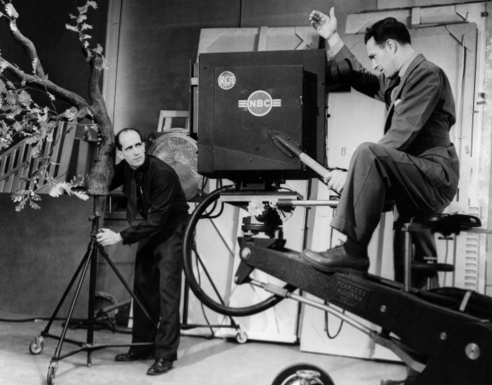
When the change from 220 lines of resolution went to 441, that was called “high definition” television. At that point, the cameras got a new NBC logo, but the color stayed the same. This is one of the three original 3H cameras just after the 441 line conversion. If you thought the remote focus on the mobile units was ahead of its time, you should know that these first pedestals were electronically operated too. With a foot switch, the cameraman could raise and lower the ped with a small motor under the center column. You can see the footswitch on the lower right.
Television’s first real studio was created at NBC in late 1935 when RCA took control of a radio studio on the third floor of 30 Rockefeller Plaza. Under a blanket of secrecy, Studio 3H was stripped, had banks of lighting installed and 3 cameras added, with all the control room equipment installed in the former radio control room on the 4th floor, which overlooked 3H.
RCA controlled this space, and all the years of equipment testing, in what was also the home of W2XBS, experimental Channel 1, until the 1939 World’s Fair opened in New York. At that time, all of RCA’s television control was turned over to NBC.
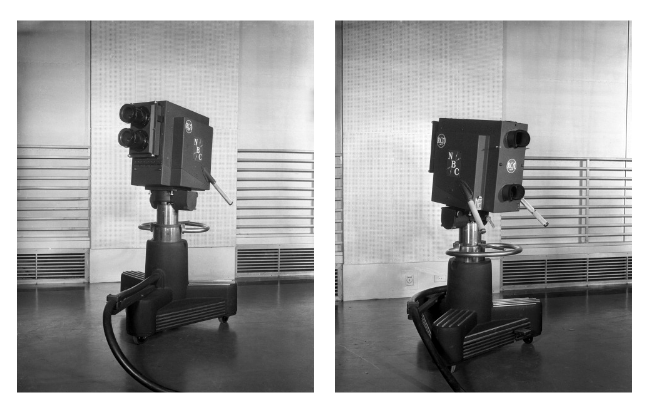
The Big Change…From 441 To 525 Lines, And Gray To Silver
Below is the camera we know as the A 500…this is the 525-line resolution camera system. RCA had sold CBS a studio Iconoscope in 1937, and by 1940, they had two more. When NBC/RCA converted their studio cameras from 441 to 525, in May of 1941, they repainted their cameras silver, and when RCA converted the CBS cameras, they painted those camera silver too. There were two reasons…to give a different look, and the silver helped reflect some of the intense heat from the studio lights.
The cameraman here is NBC’s second ever studio cameraman, Don Pike, who went on to become the network’s first ever Technical Director. On this same camera crew was a man who would become a legendary NBC TD…Heino Ripp.
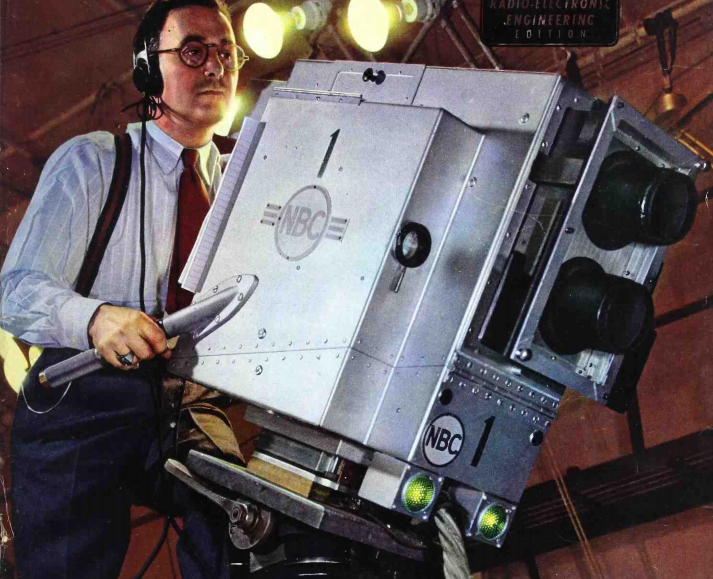
THE BIG BREAK IN REMOTE UNIT CAMERAS…From Iconoscope To Orthicon
This camera is what we believe was called the RCA Model 1840, named after the Orthicon tube inside. These cameras were first used on June 8, 1938 in television’s first ever night baseball game at Ebbets Field. Notice in the photo/article below, the new 1840 is next to its predecessor. which is one of the original field Iconoscope cameras that came with the mobile unit in 1937. The new lights in the park must have been very bright, and the camera F stops were wide open.
![]()
This is the 1840, but like the original version, and the RCA studio Iconoscopes, there was no electronic viewfinder…not on any RCA camera. That did not happen until the Image Orthicon cameras, which started with the TK series in 1946.
![]()
![]()
Below is the 1840 with a dual telephoto lens array. Although the cameraman was seeing an optical display, and not an electronic display, he had to see the visual perspective that was being fed to the Orthicon tube.
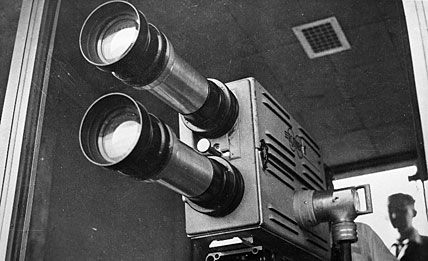
Now…a step backward? Yes and no…
Believe it or not, this is the second version of the 1840, called the 1846. It is more clunky and less sleek that the original, but had a better tube (called 1846), and was making ready to add an electronic viewfinder. There was still an optical glass viewfinder in this camera, but it was built in to “set out,” and an electronic system (with cathode ray tube) to be “set in” and plugged up, when and if the configuration could be worked out.
![]()
This is the 1846 at the Macy’s Parade rehearsal in 1942, which gives us a casual date for the first appearance of this model.

NOW…THE BIGGEST JUMP OF ALL: From Orthicon To Image Orthicon
These two photos were taken around Christmas of 1945. The location is Madison Square Garden and the event is a rodeo that is being televised by RCA for the servicemen in New York hospitals. At the bottom of this photo, with a single fixed lens, is the prototype of the new Image Orthicon camera being field tested. Above it is the RCA Model 1846 Orthicon camera, and is being used for comparison. In June of 1946, the first RCA TK 30s were delivered to NBC and used to televise the Joe Louis – Billy Conn heavyweight rematch fight at Yankee Stadium.
![]()
Here is another shot of the prototype camera at the same event. It looks like a modified 1846 chassis is being used for the IO prototype, and this looks to me to possibly have an electronic viewfinder, but maybe not. Still missing from this is the four-lens turret on the front, and the rear D handle for lens changing. Only one fixed focal length lens for now.
![]()
FINALLY…THE FIRST IMAGE ORTHICONS AND THE TK SERIES CAMERAS
Below is a very rare photo. I think was taken in the two week period between June 5 and June 18, 1946, and shows the first RCA TK30 being field tested before their big fight night debut.
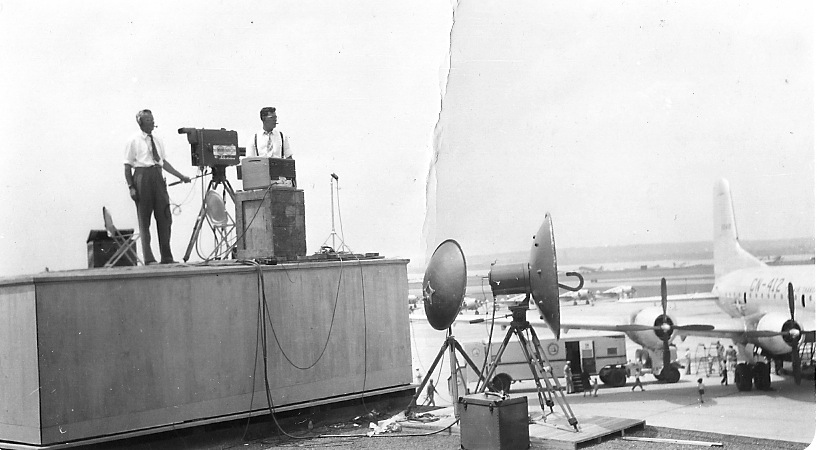
On June 19, 1946, NBC’s network broadcast of the Joe Lewis-Billy Conn rematch at Yankee Stadium was the first ever use of the RCA TK30 Image Orthicon cameras. The new truck and cameras arrived from Camden just a couple of weeks before the match. It was also the first, sponsored, live broadcast, and was presented by Gillette Razors.
Notice the camera art is the same as on the RCA A 500 Iconoscope cameras in NBC Studio 3H, and the RCA Model 1840 field Orthicon cameras. By the time the cameras went to Yankee Stadium, they had new NBC block letter logos, but until the new camera art could be decided on, this filled the bill.
Knowing that the Lewis-Conn broadcast would set records, and make history, I suspect NBC had the trucks out every day, field testing everything. I think that is what is going on here.
At the link is the October 1946 issue of RCA’s “Broadcast News” magazine, which introduces the TK30, and mentions 5 of them were on hand for the big fight.
This is fight night, and these are photos of the first ever Image Orthicon cameras in use.
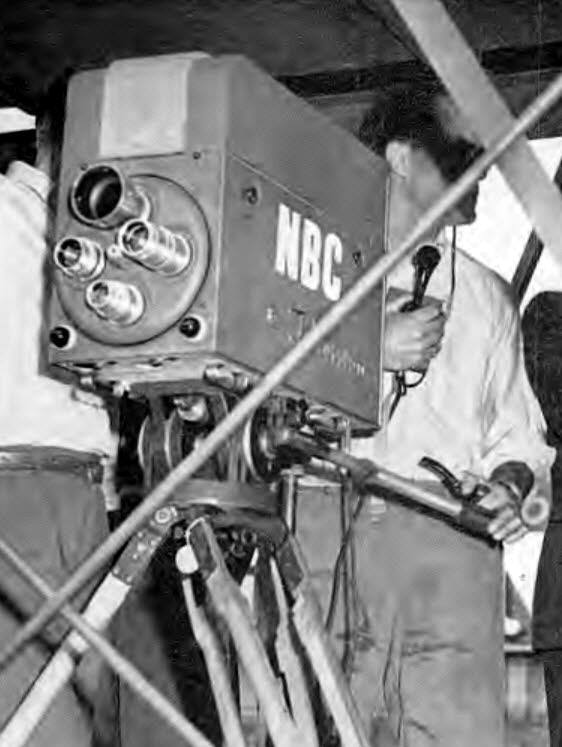
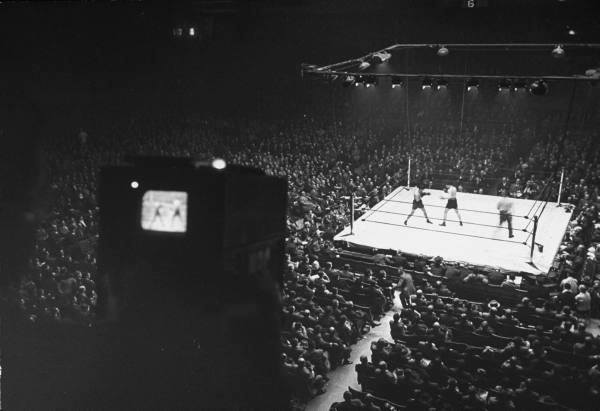
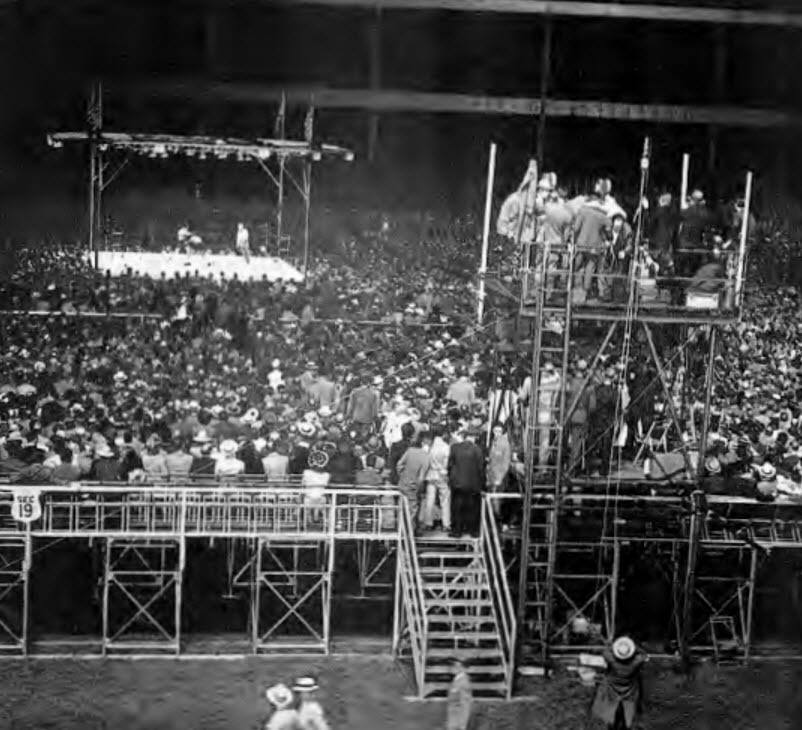
RCA’s famous TK- series of cameras started in 1946, and reigned supreme at the networks and affiliate stations for many years because of their dependability and RCA’s first-quality service. On an average, each RCA camera model was in use for at least 15 or so years. Remember, CBS had 1946 TK10s in use till 1965.
Although some of the minor models are not shown, all of the major studio size cameras used for commercial broadcast are listed and shown here, but before you click the links at the top of the page to see the cameras at work, a note about the TK Models and Versions.
TK MODELS AND VERSIONS
Starting with the introduction of the TK10/30 Image Orthicon camera in late 1946, RCA made two versions of its black and white camera models…a studio version and a field version. Except for a few cosmetic differences on their viewfinders, the TK10s and TK30s were in fact the same cameras. Unlike the 10s and 30s, the TK11 (studio) and TK31 (field) looked exactly alike and were exactly alike internally.
In essence, the difference was in the chain only. Basically, that’s what the Version number identifies. The rack mounted studio chains could be bigger and more complex because they usually never moved, but the field chains had to do the same job with suitcase sized camera control units and less power so the systems were a little different. Aside from their own chains, the TK10/30s could run on both TK11/31 chains but the 11/31s could not run on either TK10/30 chain because they needed more power.
On the TK10/30 and TK11/31 series, the first numeral following the TK is the Version Number. The second numeral is for the Model Number. For example, the Studio version of the 0 model (TK10) was always identified with a 1, and a Field version of the 0 model with a 3, as in the TK30.
Starting around 1954 with the TK40 and 41 series (which were different models with different chains), RCA began using letters to specify versions like the TK41 model with its A, B and C versions. The TK40 is not thought to ever have any letter classification, as it was discontinued when the TK41 came along. As for the TK41…it is thought that it was introduced as just the TK41 with no letter designation. When the first updates were initiated on the assembly line in Camden, that modification became the A version and sold as the TK41A, and it is thought that from then on, all prior TK41s (no letter) were either upgraded to become A versions or were just simply referred to as a TK41A.
